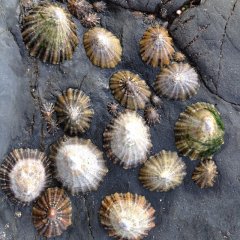 Last weekend I headed to Poldhu Cove to enjoy some sunshine and watch the surf. Having never been there the first thing I did upon arrival was head to the rocks to see what I could find, although being heavily pregnant with a toddler in tow precluded a proper nooks and crannies search of all the terrain the rocky shore had to offer. Many people might have looked at the rocky shore at Poldhu that day and concluded that there wasn't much there. Yet much like festive traditions, it was the presence of the familiar that I found comforting. Limpets, barnacles and beadlet anemones were everywhere; consequently these are often overlooked yet they all have fascinating roles to play on the rocky shore.
Last weekend I headed to Poldhu Cove to enjoy some sunshine and watch the surf. Having never been there the first thing I did upon arrival was head to the rocks to see what I could find, although being heavily pregnant with a toddler in tow precluded a proper nooks and crannies search of all the terrain the rocky shore had to offer. Many people might have looked at the rocky shore at Poldhu that day and concluded that there wasn't much there. Yet much like festive traditions, it was the presence of the familiar that I found comforting. Limpets, barnacles and beadlet anemones were everywhere; consequently these are often overlooked yet they all have fascinating roles to play on the rocky shore.
The humble common limpet Patella vulgata is an 'ecosystem engineer' of epic proportion. Their immobility at low tide belies the journeys they undertake when submerged by the tide when they crawl around grazing on microscopic algae on the rocks before returning to their home 'scar' before the tide goes out. Without limpets, our rocky shores would look quite different with some areas instead covered in thick carpets of algae.
Despite its soft body, the beadlet anemone Actinia equina is able to withstand being totally dried out when the tide falls by retracting its tentacles into its body along with some seawater. If anyone has touched the tentacles of this anemone they may recall that the tentacles felt sticky. That sensation is as a result of the harpoon shaped stinging cells, 'nematocysts', located at the end of the tentacles. The nematocysts are not only use to stun and capture prey, but also when the beadlet comes into contact with a neighbouring anemone.

Despite their size and the fact that they are covered in hard calcareous plates, barnacles are a sought after food item for many rocky shore species including dog whelks, crabs and fish. If the barnacles lose the fight, their empty shells often remain attached to the rocks and can provide a home for other species including small periwinkles and bivalves.

With the festive season upon us, it was interesting that the dominant colours on the otherwise grey shore were green and red! The bright green leaf worm Eulalia viridis stood out among the barnacles which it may have been feeding upon. Both green and red beadlet anemones were seen although one particular green beadlet anemone was distinctly stripy; something that I have not seen before and which is apparently rather unusual. A couple of large bright red strawberry anemones Actinia fragacea were also spotted. I look forward to returning to Poldhu in spring to see how it changes with the seasons.
Published: Nov 2014
Author & photographs: Dr Charlotte Marshall (Marine Lead Adviser Devon, Cornwall and Isles of Scilly Team)
